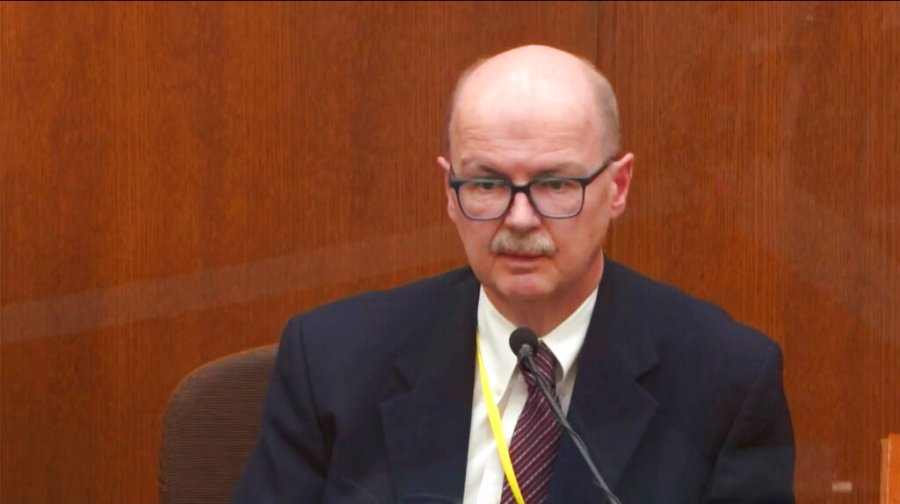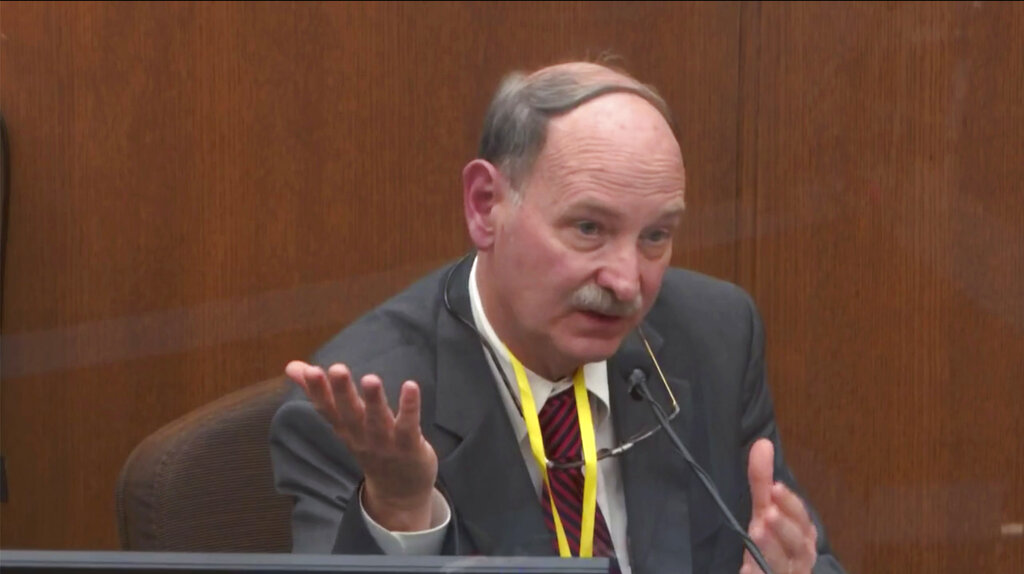Chauvin trial: Medical experts called by prosecution say Floyd died of lack of oxygen, not drug overdose
MINNEAPOLIS (NewsNation Now) — A critical care doctor called as a prosecution witness in Derek Chauvin’s murder trial testified Thursday that George Floyd died from a lack of oxygen caused by being handcuffed face down in the street with the former Minneapolis police officer’s knee on his neck.
Chauvin, who is white, pressed his knee into the neck of Floyd, a 46-year-old Black man in handcuffs, for about nine minutes on May 25, 2020. Chauvin has pleaded not guilty to murder and manslaughter charges for Floyd’s arrest, which happened on suspicion that Floyd used a fake $20 bill to buy cigarettes at a convenience store.
The county medical examiner has ruled Floyd’s death a homicide at the hands of the police. Chauvin’s lawyers have argued Floyd’s death was from a drug overdose, although prosecutors have said medical evidence would contradict that.
NewsNation will provide live coverage of the trial online and the NewsNation Now app. You can watch the trial here.
lung and breathing researcher Dr. martin tobin
The first witness called by the prosecution Thursday morning was Martin J. Tobin, MD, a physician that specializes in pulmonary and critical care medicine at Edward Hines Jr. VA Hospital and Loyola University’s medical school in Illinois.
Tobin has been engaged in medical research regarding the breath and the study of lungs since 1981. When asked Floyd’s cause of death, Tobin stated a “low level of oxygen” leading to subsequent brain injury resulting in pulseless electrical activity (PEA) arrhythmia that caused his heart to stop.

Tobin reviewed various videos of the arrest and testified that several factors in addition to Chauvin’s knee on Floyd’s neck created a type of “vise” grip on Floyd’s breathing. Those additional factors included how the handcuffs were applied, the hard street, the knee on his back, and being in the prone position.
But Tobin said other factors worsened the effect on Floyd: He pointed out that Officer J. Kueng held Floyd’s left hand upward, and Chauvin’s right knee compressed Floyd’s side, meaning “the ability to expand his left side is enormously impaired.”
At one point the physician addressed the jury directly and in a professorial tone explained the anatomy of the neck to explain why the placement of Chauvin’s knee on the hypopharynx (an anatomical feature of the throat) was crucial to blocking oxygen from entering the airway.
Tobin testified that if the hypopharynx – the bottom part of the throat — becomes totally obstructed, it takes just seconds to reduce the level of oxygen to where it would result “in either a seizure or a heart attack.”
Tobin also testified that at times Chauvin was nearly vertical when pressing his knee into Floyd’s neck. He estimated that when the officer’s toes were on the ground, the body weight on the neck was 86.9 lbs. versus when his toes were off the ground, half of Chauvin’s body weight 91.5 lbs. was directly compressing the neck.
While Floyd was speaking for the first 4 minutes 51 seconds, there was not complete compression of his neck. However, Tobin said using a person’s vocalization or talking as a measure for breathing isn’t an adequate gauge as brain damage happens quickly.
Chauvin kept his knee on Floyd’s neck for 3 minutes, 2 seconds, after Floyd had “reached the point where there was not one ounce of oxygen left in the body,” Tobin said.
Forensic toxicologist Daniel Isenschmid
Forensic toxicologist Daniel Isenschmid was the second witness to take the stand Thursday, testifying that he tested blood drawn from Floyd at the hospital, as well as urine from his autopsy, and found a “very low” amount of methamphetamine.

Isenschmid said fentanyl and a byproduct of its breakdown in the body were also found.
Isenschmid put the level of fentanyl in Floyd’s blood at 11 nanograms per milliliter. For perspective, he said that testing of more than 2,000 people arrested for driving under the influence of fentanyl revealed an average concentration of 9.59, and dozens of them had levels higher than Floyd’s — and lived.
On cross-examination, Nelson suggested there was no way to know how much fentanyl Floyd had ingested, and Isenschmid agreed. The defense attorney also said it’s impossible to know the concentration of fentanyl in illegal street drugs.
“Every single pill you take, it becomes a unique experience for the person, right?” Isenschmid agreed.
physician in forensic medicine dr. bill smock
Dr. Bill Smock, an expert on deaths from asphyxia, was the third witness to take the stand Thursday. He agreed with Tobin’s assessment.
Smock said Floyd did not have symptoms of a fentanyl overdose such as constricted pupils and decreased breathing. He said Floyd’s actions were the opposite, because he was pleading for air.
“That is not a fentanyl overdose. That is somebody begging to breathe,” said Smock, the police surgeon for the Louisville, Kentucky, department. He said Floyd died of “positional asphyxia,” a lack of oxygen because of the position of the body.

“No force was reasonable in that position”
Here are some of the important moments from the eighth day of testimony on Wednesday:
A national use-of-force expert Sgt. Jody Stiger with the Los Angeles Police Dept. has reviewed 2,500 cases in which police used force, resumed his testimony on Tuesday.
Stiger told jurors that the handcuffed Floyd posed no immediate threat and was not actively resisting when Chauvin used deadly force on him.
“My opinion was that no force was reasonable in that position,” Stiger testified. He said pressure caused by Chauvin’s body weight could have led to asphyxia and death.
Questioned by defense lawyer Eric Nelson, Stiger agreed that a police officer needed to take into account various factors during a fluid situation when considering how much force to use.
“It has to be proportional,” Stiger said. “You are constantly reassessing during the time frame.”
Nelson showed Stiger photographs taken at different times of the incident and asked whether Chauvin’s knee was on Floyd’s shoulder blades rather than his neck.
“It appears to be more above the shoulder blades than on the shoulder blades,” Stiger testified.
“I ate too many drugs.” OR “I ain’t do no drugs.”
Prosecutors called Minnesota Bureau of Criminal Apprehension Sr. Special Agent James Reyerson, an expert on the use of force and the lead investigator in the case.
Reyerson testified that six months after the incident, Chauvin’s lawyers found what was later determined to be pills that had Floyd’s DNA on them in the police squad car into which officers tried to put Floyd. Chauvin’s defense has said the pills contained methamphetamine and fentanyl.
Part of Nelson’s strategy for defending Chauvin has been to say Floyd’s death was due to illegal drug use.
Nelson played a short clip of the arrest incident, which came from another officer’s body camera video, showing a chaotic and noisy scene as Floyd, handcuffed and laying on his stomach, yelled and moaned in distress.
“Does it sound like he says, ‘I ate too many drugs?’” Nelson asked.
Reyerson agreed with Nelson that it sounded on one video of the incident as if Floyd said he “ate too many drugs.”
But during further questioning from the prosecutor Matthew Frank, Reyerson testified differently.
He got Reyerson to say he had not closely listened to that passage before. After a break to regroup, Frank replayed a longer clip from the same body cam video,
“Having heard it in context, you’re able to tell what Mr. Floyd is saying there?” Frank asked.
“I believe Mr. Floyd was saying, ‘I ain’t do no drugs,’” Reyerson replied.
“So that’s a little different than what you were asked about when you only saw a portion of the video, correct?′ Frank asked.
“Yes, sir,” the agent said.
The Associated Press and Reuters contributed to this report. Reporting by Jonathan Allen and Brendan O’Brien of Reuters. Reporting by Amy Forliti, Steve Karnowski and Tammy Webber of AP.










